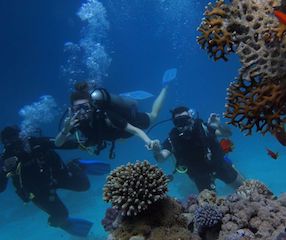The PADI Open Water Diver final exam consists of 50 questions, so we have included a few general knowledge safety practice questions (and answers) to help you study for this test. Most of the PADI Open Water Diver final exam questions are multiple-choice questions, along with a couple of ‘ place the answers in the correct order’ questions. You don’t have a time limit to complete the exam. In fact, you most likely have seen the questions in the review sections of your book in one form or another. All of the review sections in the book are extremely helpful when preparing to take the test, and there is no downside to doing them, right?
If you are looking for 12 PADI Open Water Dive Safety practise questions you are in the right place. Don’t stress out as this test is designed for an 10+ year-old to pass!
If you are looking for 55 PADI Open Water Diver Final Exam Practise Questions, then read this article instead!
Download a formatted copy of the 55 practise Open Water Diver Q&As and print it out in preparation for your test.
Book a 30 minute Coaching Call on Zoom
If you would like help preparing for your Open Water Exam and need to ask a few questions from a PADI Divemaster then book a call with Schuan.
Schuan is a PADI Freediver, Divemaster and Scuba Instructor who would like to help you prepare for your exam.
He is a professional Commercial Diver with Australian Diver Accreditation Scheme (ADAS) Part 1-3 certified licenses, IMCA Dive Medic Technician (DMT) and Assistant Life Support Technician (ALST). He is currently working on material with us to help others in their professional careers.
Link to Book in: https://payhip.com/b/QqPXw
General Knowledge:
Question 1
What are your top 3 Buddy safety concerns?
Answer:
Gas (OOT)
Hazards
Thermal
Multiple Choice and True or False Questions
Question 1
What’s the most common diving-related injury?
A) Ear injuries
B) Decompression Illness
C) Lionfish stings
D) Shark Attacks
Answer: A
Question 2
I am close to my buddy and realize I am out of air. The best response is to
A) switch to my buddy’s alternate air source.
B) make a controlled emergency swimming ascent (swim up to the surface making a continuous sound, like ah-h-h-h).
C) make a buoyant emergency ascent (dropping my weight system).
D) switch to my buddy’s alternate air source and continue the dive.
Answer: A Switch to my buddy’s alternate air source.
When out of air, your best option is usually to make an alternate air source ascent using your buddy’s alternate air source.This allows you to continue breathing while your buddy assists you with the ascent. Answer D is wrong. You should not continue the dive.
See Being a Diver III – Underwater Problem Management.
Question 3
I’m using brand-new equipment that I’ve never used before. I can just throw it on and jump right in to make a dive.
False. I should familiarize myself with the kit or get additional training.
True. I’m a certified diver. I can figure it out.
Answer: False
Question 4
The first step in handling an accident is:
A) Assure that the scene is safe before I provide care
B) Jump into the water and swim out to the injured diver
C) Get the first aid kit
D) Look for someone to blame
Answer: A
Question 5
If I were separated from my buddy, the general procedure is to
A) go up immediately, wait a minute and then go back down.
B) search for a minute and then go up to reunite with my buddy at the surface.
C) go to the surface immediately and get out of the water.
D) look for my buddy’s bubbles and follow the bubbles to find my buddy.
Answer: B Search for a minute and then go up to reunite with my buddy at the surface.
The general procedure for buddy separation is to search for no more than one minute, then surface to reunite.
See Being a Diver II – The Buddy System.
Question 6
Before making a dive, my buddy and I should do a buddy check. What are the steps?
A) BWRAF-BCD, Weights, Releases, Air, Final OK
B) SORTeD-Signal, orient, regulator, time, equalize, descend
C) H2TG: head-to-toe glance
D) Buddy Check? What’s that?
Answer: A
Question 7
It’s okay to reach inside crevices on a coral reef.
False
True.
Answer: False
Question 8
I should look at my entry area before I make a giant stride off of a dive boat.
True. It’s always good to look before you leap.
False. The divemaster said it was okay, so I’ll just jump right in.
Answer: True
Question 9
When exiting the water and climbing a ladder onto the boat, I should:
A) Stay as close to the ladder as possible
B) Stay back a bit, probably holding onto the tag line
C) Stay underwater, under the ladder
Answer: B
Question 10
Which of the following are suggested pieces of first aid equipment when on a diving excursion?
A) First Aid Kit
B) Emergency Oxygen KIt
C) Radio or cell phone to call for help
D) All of these
Answer: D
Question 11
There is an injured diver who is out of the water and is not responding to touch or my voice. The first thing to do would be
A to check if the diver is breathing.
B to keep the diver warm.
C to decide what happened.
D to provide oxygen.
Answer: A To check if the diver is breathing.
Your priority when assisting someone who is unresponsive is to make sure the diver is breathing. Provide rescue breaths as necessary. Contact emergency medical care.
See Being a Diver III – First Responder Care for Diving-Related Emergencies.

